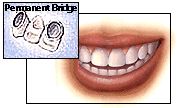CROWNS
When a tooth is
fractured, has a large, old filling, or is severely damaged by
decay, your dentist may recommend the placement of a crown, or
cap. Crowns strengthen and protect the remaining tooth structure
and can improve the appearance of your smile. Types of crowns
include the full porcelain crown, the porcelain-fused-to-metal crown
and the all-metal crown.
Fitting a crown requires at least two visits to the dentist's
office. Initially, the Dentist:
|
 |
 |
Removes decay and shapes the
tooth. |
| Makes an Impression. |
 |
 |
 |
 |
Makes
and fits a temporary or transitional crown of plastic or
metal. |
In a subsequent
visit, the
dentist:
Removes the temporary
crown, fits and adjusts the final crown. Cements the crown into
place. |
 |
 | |
|
BRIDGES
Few incidents
have greater impact on dental health and personal appearance than
tooth loss. When one or more teeth are missing, the remaining
teeth can drift out of position, which can lead to a change in the
bite, the loss of additional teeth, decay and gum
disease.
When tooth loss
occurs, your dentist may recommend the placement of a bridge. A
bridge is one or more replacement teeth anchored by one or
more crowns on each side. |
 |
 |
Initially, the dentist
prepares teeth on each side of the space to receive crowns and makes
an impression of the entire area. |
 |
 |
Fits
a temporary or transitional bridge. |
 |
 |
In
a subsequent visit, the dentist
places, adjusts and cements the fixed
bridge. |
|
Be sure to follow the special home
care instructions provided by your dental
professional. | |